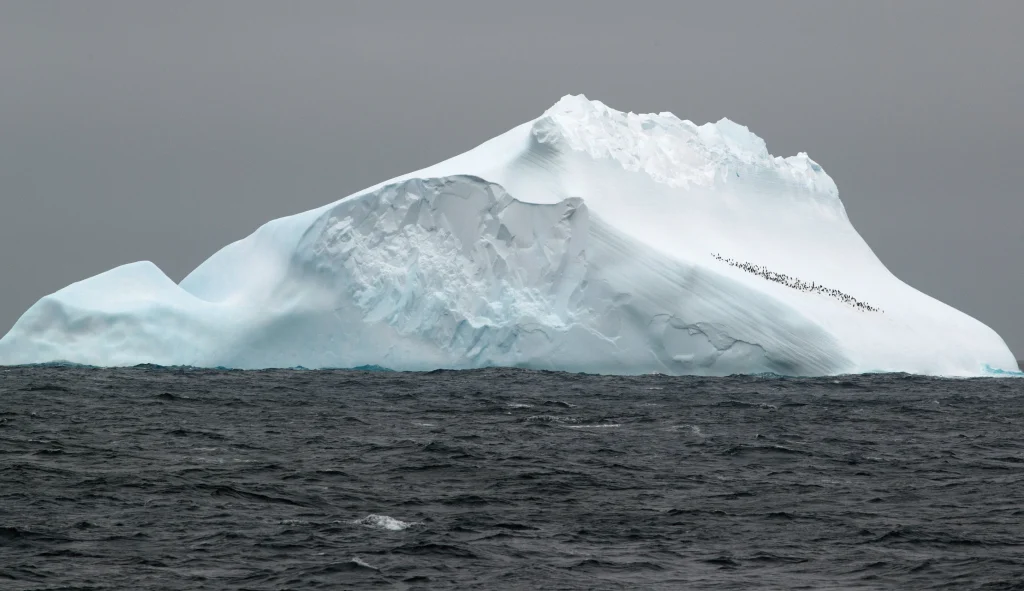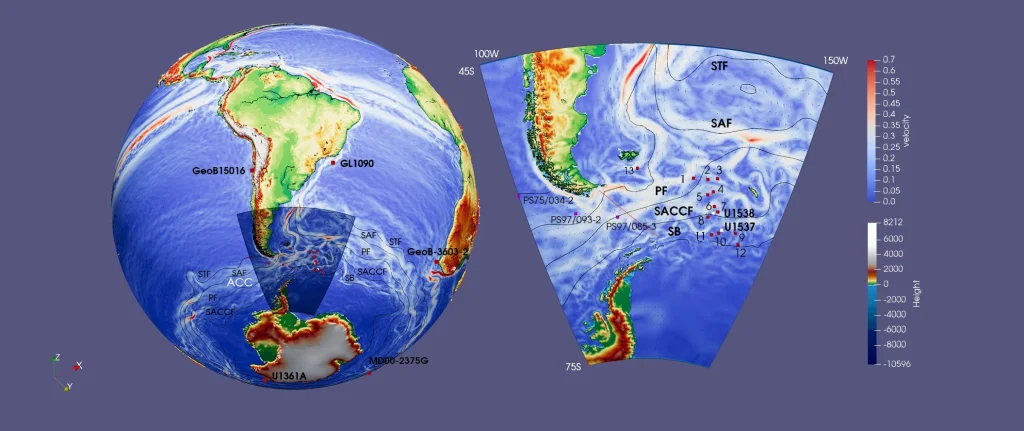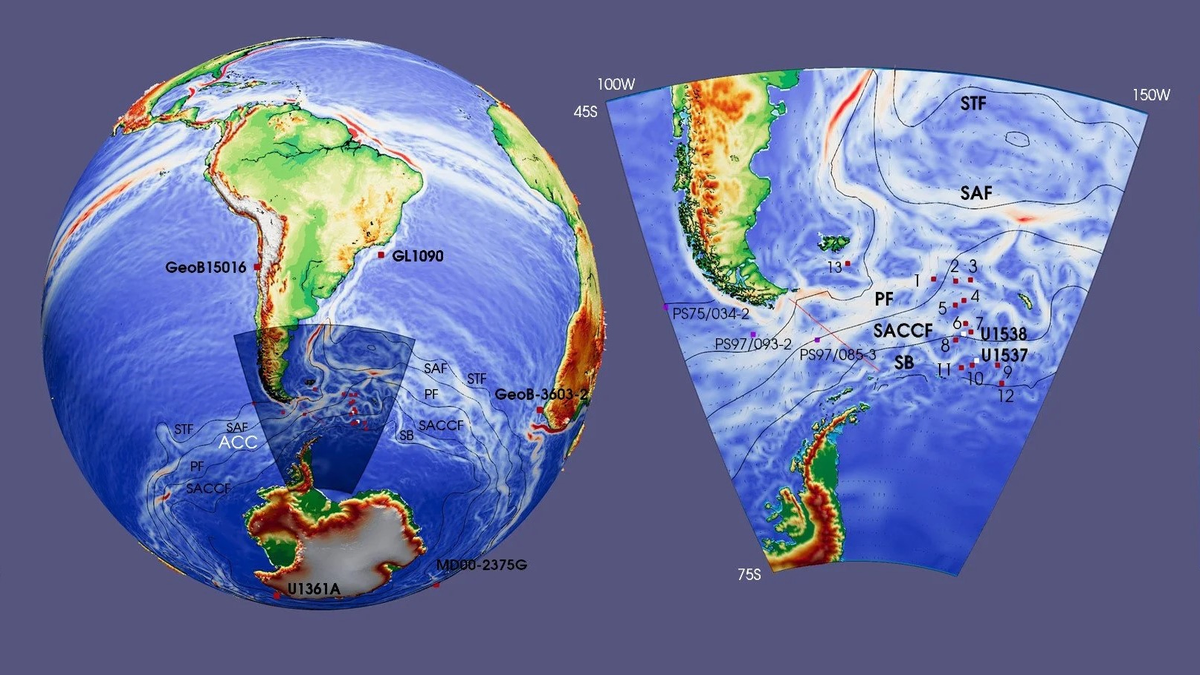The Antarctic Circumpolar Current (ACC) encircles Antarctica between roughly 45°S and 70°S, flowing endlessly from west to east. It connects all major oceans and shapes the exchange of heat, carbon, and nutrients that regulate Earth’s climate system.
Even minor latitudinal movements of the ACC can alter global temperature distribution, sea-ice extent, and marine productivity. Because it isolates Antarctica from warmer waters, its position also determines how quickly the ice sheet gains or loses mass.
A new international study, published in Nature Communications on October 6, 2025, shows that the ACC was positioned about 5° of latitude further south, roughly 600 km (370 miles)—during the last interglacial warm period, around 130 000 years ago. The finding helps explain why sea levels then stood 6–9 m (20–30 feet) higher than today.
Yet the same study suggests that over the coming millennia, natural orbital factors will favor a gradual northward shift of the current. This natural trend may act in the opposite direction to human-driven climate change, which is expected to strengthen westerly winds and push the ACC southward.
For scientists, understanding how these forces interact is essential for predicting the ocean’s long-term role in storing heat and carbon dioxide.
 Iceberg in the Scotia Sea. Credit: Thomas Ronge
Iceberg in the Scotia Sea. Credit: Thomas Ronge
Evidence locked in Scotia Sea sediments
To trace the ACC’s ancient movements, researchers collected sediment cores from the Scotia Sea, located north of the Antarctic Peninsula. This region lies downstream of the Drake Passage, where the ACC exits the Pacific and enters the Atlantic. Because the frontal systems there are wide and unconstrained by land, it is an ideal site for detecting shifts in current strength and position.
The expedition, conducted aboard the drilling vessel JOIDES Resolution in 2019 under the International Ocean Discovery Program (IODP), retrieved samples from depths of 3 000–4 000 m (9 840–13 120 feet). Each layer of mud captured particles carried by bottom currents across tens of thousands of years.
The team analyzed the size of silt particles, coarser grains indicate faster near-bottom flow, as stronger currents are capable of transporting larger sediments before they settle. By measuring these subtle variations, the scientists reconstructed how current velocity changed over the last 160 000 years.
The results showed that during the Last Interglacial, a warm period preceding the current Holocene, bottom-current speeds were more than three times greater than today. This surge in flow energy coincided with a southward shift of the ACC’s Polar Front, which brought warmer waters closer to the Antarctic coastline.
Because the study focuses on near-bottom speeds, it reveals how the deep flow behaved, rather than the surface currents alone. However, in the ACC system, deep and surface currents are closely coupled, meaning both likely moved together.
Orbital mechanics reshape ocean circulation
The researchers linked the observed acceleration to Earth’s orbital variations. Around 130 000 years ago, the planet’s orbit was more elliptical, increasing seasonal differences in sunlight between hemispheres. At the same time, axial tilt and precession, the wobble of Earth’s rotational axis, reached reinforcing maxima.
Orbital alignments strengthened the Southern Hemisphere’s westerly winds, the main driver of the ACC. With stronger winds came faster flow and a poleward (southward) displacement of the current’s main fronts.
The study shows that these changes follow predictable cycles. Long-term trends correspond to the 100 000-year eccentricity cycle, while shorter oscillations track the 21 000-year precession cycle. When both coincide at their peaks, the ACC moves south; when both weaken, it drifts north.
Based on current orbital geometry, natural forcing should now be favoring a northward tendency that will unfold over tens of thousands of years.
 The maps show today’s (Holocene) global ocean surface currents – warmer red colors represent higher current velocities. The black lines are the five main fronts of the Antarctic Circumpolar Current (ACC), from north to south. The red line marks Jason Route 104 near the Drake Passage (DP)45. The shaded area in the map left is the area concerned in the study (image right). Credit: Xufeng Zheng
The maps show today’s (Holocene) global ocean surface currents – warmer red colors represent higher current velocities. The black lines are the five main fronts of the Antarctic Circumpolar Current (ACC), from north to south. The red line marks Jason Route 104 near the Drake Passage (DP)45. The shaded area in the map left is the area concerned in the study (image right). Credit: Xufeng Zheng
The delicate balance of wind, water, and ice
The Antarctic Circumpolar Current does more than connect oceans; it controls how efficiently Earth’s deep waters store heat and carbon dioxide. Its position influences where cold, nutrient-rich water rises to the surface and where warm, oxygen-poor water sinks back into the abyss.
A northward shift could expose more of the Southern Ocean to upwelling, enhancing biological productivity and cooling some southern mid-latitudes. A persistent southward migration, however, would expose Antarctic ice shelves to warmer water, accelerating melting and raising global sea levels.
The 2025 study emphasizes that both processes may occur simultaneously at different scales. Regional variations, driven by topography and ocean eddies, can temporarily mask or amplify these trends.
Modeling the interactions accurately requires long records of natural variability, such as those now available from the Scotia Sea. Geological archives show that the ACC has never been static; it responds to subtle astronomical triggers that repeat across ages.
Understanding this deep-time behavior offers a powerful baseline for interpreting current satellite and oceanographic observations, which span only a few decades by comparison.
Decoding nature’s rhythm
For oceanographers, the next step is to merge ancient sediment records with modern climate models. Only by combining these approaches can scientists distinguish how much of today’s ocean shift stems from human influence and how much reflects the planet’s intrinsic rhythm.
Lead author Xufeng Zheng notes that such integration is essential for accurate prediction. “In future research, it will be vital to combine geological records of the past and climate modeling.”
The work also shows the complexity of feedbacks in the Southern Ocean, where even small wind changes can reorganize the planet’s largest current system.
By uncovering how orbital cycles once rearranged the ACC, this study provides a rare glimpse of the mechanisms that will shape Earth’s oceans far beyond the next century.
Whether natural or human-driven, the forces acting on the circumpolar current remind us that climate change unfolds across both human and planetary timescales.
References:
1 Is the Circumpolar Current Shifting Back North? – University of Bonn – October 7, 2025
2 Extremely poleward shift of Antarctic Circumpolar Current by eccentricity during the Last Interglacial – Lijuan Lu et al. – Nature Communications – October 6, 2025 – https://doi.org/10.1038/s41467-025-63933-x – OPEN ACCESS

